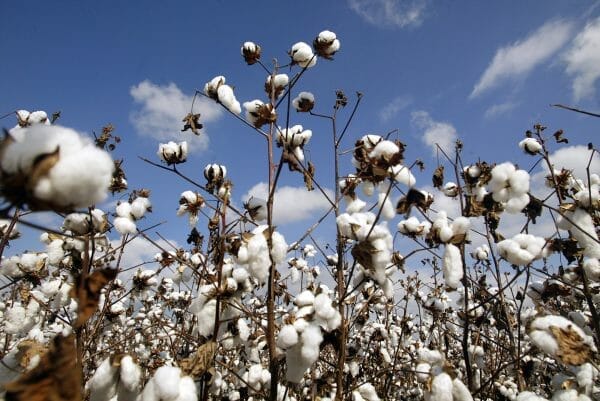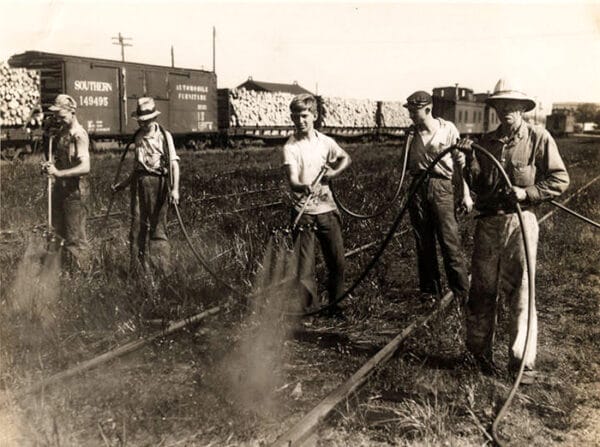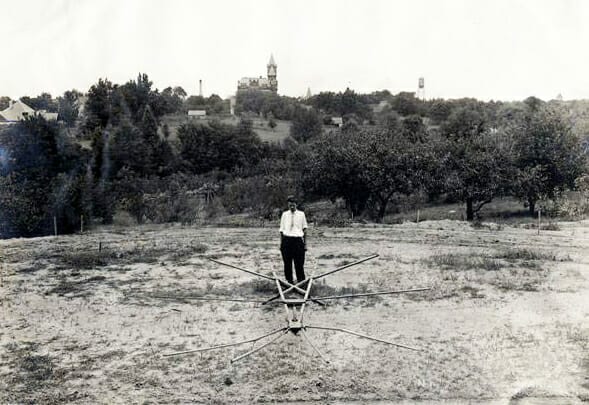Boll Weevil in Alabama
 Boll Weevil
The insect known as the boll weevil (Anthonomus grandis) decimated the cotton-based agriculture in Alabama and the rest of the cotton-growing states in the South beginning in the early twentieth century. Hundreds of landowners were forced to sell their land and even more tenant farmers and sharecroppers left the South, with many moving north and west in search of employment in what has become known as the Great Migration. Those who remained turned to other crops and agricultural commodities, including corn, peanuts, and livestock, a result praised by some because it forced the diversification of southern agriculture. Despite numerous efforts to counter the pest and its impact, only in recent years has the weevil been brought under control. Weevils first entered the United States from Mexico in 1892. They reached Mobile County in 1910 and had infested the entire state by 1916. Alabama’s economy was almost entirely based in agriculture, with cotton being the primary cash crop, when the weevil arrived. Losses during the initial years of infestation reached 60 to 75 percent. Because farmers, and the many industries that depended on them, could not shift to alternate sources of revenue quickly during the first half of the twentieth century, the state’s economy was devastated. In 1950, the worst year of the crisis, losses in the U.S. reached $750 million. Economic losses to the weevil in Alabama were $20 to $40 million each year for more than 80 years. Some historians consider the boll weevil the most important event in Alabama history until the mid-twentieth century, eclipsed only by the Civil War.
Boll Weevil
The insect known as the boll weevil (Anthonomus grandis) decimated the cotton-based agriculture in Alabama and the rest of the cotton-growing states in the South beginning in the early twentieth century. Hundreds of landowners were forced to sell their land and even more tenant farmers and sharecroppers left the South, with many moving north and west in search of employment in what has become known as the Great Migration. Those who remained turned to other crops and agricultural commodities, including corn, peanuts, and livestock, a result praised by some because it forced the diversification of southern agriculture. Despite numerous efforts to counter the pest and its impact, only in recent years has the weevil been brought under control. Weevils first entered the United States from Mexico in 1892. They reached Mobile County in 1910 and had infested the entire state by 1916. Alabama’s economy was almost entirely based in agriculture, with cotton being the primary cash crop, when the weevil arrived. Losses during the initial years of infestation reached 60 to 75 percent. Because farmers, and the many industries that depended on them, could not shift to alternate sources of revenue quickly during the first half of the twentieth century, the state’s economy was devastated. In 1950, the worst year of the crisis, losses in the U.S. reached $750 million. Economic losses to the weevil in Alabama were $20 to $40 million each year for more than 80 years. Some historians consider the boll weevil the most important event in Alabama history until the mid-twentieth century, eclipsed only by the Civil War.
 Baldwin County Cotton
In the early years of infestation, farmers tried numerous methods, including home-made insecticides and even controlled burning, to eradicate or minimize the damage brought on by the weevil. Farmers also tried cultural practices, such as planting cotton earlier and encouraging earlier maturity of the crop. Farmers found that the best way to escape the devastation brought on by the weevil was to switch to other crops. In the Wiregrass region of southeastern Alabama, farmers began planting peanuts. Farmers in north Alabama found that the weevil was kept somewhat at bay by low winter temperatures, so cotton planting during the weevil era shifted heavily to northern areas of the state.
Baldwin County Cotton
In the early years of infestation, farmers tried numerous methods, including home-made insecticides and even controlled burning, to eradicate or minimize the damage brought on by the weevil. Farmers also tried cultural practices, such as planting cotton earlier and encouraging earlier maturity of the crop. Farmers found that the best way to escape the devastation brought on by the weevil was to switch to other crops. In the Wiregrass region of southeastern Alabama, farmers began planting peanuts. Farmers in north Alabama found that the weevil was kept somewhat at bay by low winter temperatures, so cotton planting during the weevil era shifted heavily to northern areas of the state.
 Boll Weevil Control
In 1918, at the urging of Extension Service agents, farmers began using the insecticide calcium arsenate, which provided some relief from weevils through the mid-1940s. At that time, scientists began developing a new class of insecticides, the chlorinated hydrocarbons, which included Toxaphene, BHC, and DDT. These pesticides proved very effective, but by the 1950s farmers had become heavily dependent on them and had stopped maintaining the cultural practices they developed earlier. As a result, the weevil developed resistance to these chemicals before the decade was over. This development was likely a good thing for the environment, however, because these insecticides persisted in soil and water and caused harmful effects in birds, fish, and other wildlife. In the early 1960s, scientists developed an even more effective class of chemical insecticides, the organophosphates, which included methyl parathion, azinphosmethyl (Guthion), and malathion. These chemicals did not linger in the environment like the chlorinated hydrocarbons, but they were acutely toxic to humans and other warm-blooded animals. Indeed, this class of chemistry originated with the development of nerve gases used during World War II.
Boll Weevil Control
In 1918, at the urging of Extension Service agents, farmers began using the insecticide calcium arsenate, which provided some relief from weevils through the mid-1940s. At that time, scientists began developing a new class of insecticides, the chlorinated hydrocarbons, which included Toxaphene, BHC, and DDT. These pesticides proved very effective, but by the 1950s farmers had become heavily dependent on them and had stopped maintaining the cultural practices they developed earlier. As a result, the weevil developed resistance to these chemicals before the decade was over. This development was likely a good thing for the environment, however, because these insecticides persisted in soil and water and caused harmful effects in birds, fish, and other wildlife. In the early 1960s, scientists developed an even more effective class of chemical insecticides, the organophosphates, which included methyl parathion, azinphosmethyl (Guthion), and malathion. These chemicals did not linger in the environment like the chlorinated hydrocarbons, but they were acutely toxic to humans and other warm-blooded animals. Indeed, this class of chemistry originated with the development of nerve gases used during World War II.
 Boll Weevil Trap
The 1960s saw a decrease in crop losses, but the use of phosphate insecticides resulted in resistance in, and subsequent outbreaks of, other pests of cotton, such as the tobacco budworm. Fearing that weevils might also develop resistance to this class of insecticides, scientists began to increase their efforts to develop technology that would achieve eradication of the boll weevil, a goal that traced back to the beginning of infestation. Toward that end, the U.S. Department of Agriculture (USDA) established the Boll Weevil Research Laboratory in Mississippi in 1962. During the next 15 or so years, scientists devised several techniques that had the potential to make eradication feasible, in the opinions of most entomological researchers. The research facility set up several small-scale eradication trials and in 1979 established a formal, large-scale program in North Carolina. The efforts included pheromone traps baited with a synthetic weevil mating attractant to detect where weevils still existed and malathion spraying on weevil-infested fields. Many fields received 18 to 20 or more sprays annually, for consecutive years, in order to kill the last weevil.
Boll Weevil Trap
The 1960s saw a decrease in crop losses, but the use of phosphate insecticides resulted in resistance in, and subsequent outbreaks of, other pests of cotton, such as the tobacco budworm. Fearing that weevils might also develop resistance to this class of insecticides, scientists began to increase their efforts to develop technology that would achieve eradication of the boll weevil, a goal that traced back to the beginning of infestation. Toward that end, the U.S. Department of Agriculture (USDA) established the Boll Weevil Research Laboratory in Mississippi in 1962. During the next 15 or so years, scientists devised several techniques that had the potential to make eradication feasible, in the opinions of most entomological researchers. The research facility set up several small-scale eradication trials and in 1979 established a formal, large-scale program in North Carolina. The efforts included pheromone traps baited with a synthetic weevil mating attractant to detect where weevils still existed and malathion spraying on weevil-infested fields. Many fields received 18 to 20 or more sprays annually, for consecutive years, in order to kill the last weevil.
In addition to these efforts, the USDA increased funding to the Cooperative Extension Services in each cotton-producing state during the 1970s. These funds were used to increase personnel and develop education programs to better manage the boll weevil. Programs included field monitoring, in which scouts surveyed fields for the presence of weevils; the use of treatment thresholds to determine the most economical time to spray; and other cultural or management tools. When enacted together, these various methods were combined under the term Integrated Pest Management (IPM). After proving successful, eradication programs were expanded to include South Carolina in 1983, and Georgia and southern Alabama in 1987. During the next eight years, the program expanded throughout Alabama. As program personnel worked to implement eradication, they encountered many problems, which included underestimating costs and labor shortages. Other issues included negative environmental effects associated with aerial pesticide applications and outbreaks of other destructive pests. When eradication was achieved in Alabama, yields improved significantly and insecticide inputs decreased dramatically. After suffering tremendous losses in their harvests and investing massively in insecticides for almost 80 years, Alabama farmers were now able produce two bales of cotton per acre in years with good rainfall and were freed almost completely from using foliar insecticides. Since 1995, no economic damage resulting from the weevil has been reported from Alabama. The last weevil captured was a single find in Mobile County in 2003.
At about the time that weevils were eradicated, seed for genetically altered varieties of cotton became available to growers. These new varieties repelled worm pests and encouraged beneficial insects to help with some other pests. A few insect pests of cotton, such as plant bugs and stink bugs, occasionally build to levels requiring spraying in this low-insecticide environment, but none will likely ever have the potential to cause catastrophic losses like the weevil.
 Boll Weevil Monument
The boll weevil had profound and devastating effects on agriculture and society in Alabama for much of the twentieth century. A number of very positive and long-lasting effects grew out of that devastation, however, including the diversification of agriculture, the rise of the science of entomology in the South, and advancements in insect-control methods, such as the aerial application of pesticides. Notably, the boll weevil sparked the development of the Cooperative Extension Service and the growth and importance of the agricultural experiment stations. In addition, the process of weevil eradication renewed interest in the philosophy of IPM, the development of field scouting, and the rise of the agricultural private consulting industry. Cotton planting has once again become a viable agricultural pursuit for farmers in southern Alabama, where it has become as excellent rotational crop with peanuts. The benefits brought to the Wiregrass region were commemorated by the city of Enterprise, in Coffee County, with the dedication of the Boll Weevil Monument in 1919, with the weevil portion being added some 30 years later.
Boll Weevil Monument
The boll weevil had profound and devastating effects on agriculture and society in Alabama for much of the twentieth century. A number of very positive and long-lasting effects grew out of that devastation, however, including the diversification of agriculture, the rise of the science of entomology in the South, and advancements in insect-control methods, such as the aerial application of pesticides. Notably, the boll weevil sparked the development of the Cooperative Extension Service and the growth and importance of the agricultural experiment stations. In addition, the process of weevil eradication renewed interest in the philosophy of IPM, the development of field scouting, and the rise of the agricultural private consulting industry. Cotton planting has once again become a viable agricultural pursuit for farmers in southern Alabama, where it has become as excellent rotational crop with peanuts. The benefits brought to the Wiregrass region were commemorated by the city of Enterprise, in Coffee County, with the dedication of the Boll Weevil Monument in 1919, with the weevil portion being added some 30 years later.
Further Reading
- Braund, Kathryn Holland. “‘Hog Wild’ and ‘Nuts: Billy Boll Weevil Comes to the Alabama Wiregrass.” Agricultural History 63 (Summer 1989): 15-39.
- Deterling, Del. “The Boll Weevil: 100 Years of War.” Progressive Farmer 107 (October 1992): 26-28.
- Haney, Phillip B., ed. Boll Weevil Eradication in the United States through 1999. The Cotton Foundation Reference Book Series, No. 6. Memphis, Tenn.: Cotton Foundation, 2001.



